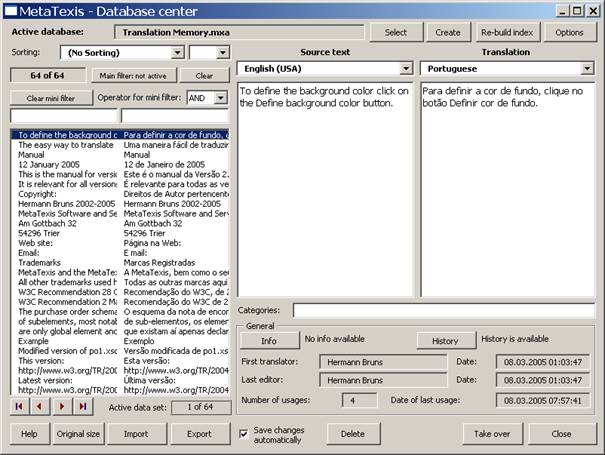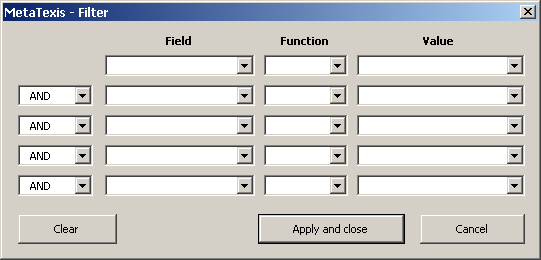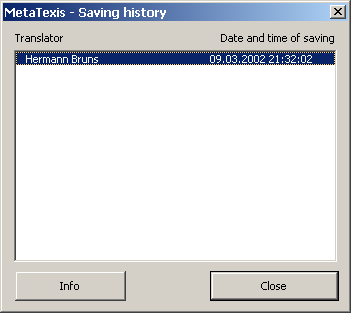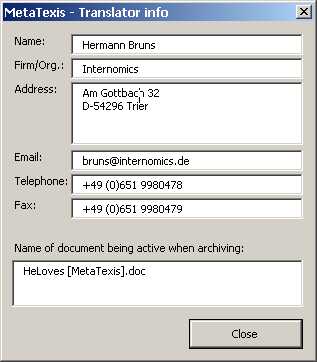
The elements and functions of the database center for TMs are explained in the following paragraphs:

· The name of the active database is shown in a gray text box right below the title bar of the dialog box. (If, for some reason, no database is selected, this is indicated in red.)
Right next to it, near the upper right hand corner there are the two buttons: Select and Create. These buttons allow you to change the TM being displayed. In fact you can display any TM by selecting a database from the dialog box shown and clicking on the Select button. By clicking on the Create button you can create and display new databases.
· The left side of the dialog box contains all you need for sorting, filtering, and navigating through the TM being displayed.
▪ Sorting:
You can sort the TUs in several ways. To change the sorting rule, select another item from the Sorting drop-down-list.
Moreover, you can choose between ascending and descending order in the drop-down-box located at its side.
▪ Main filter:
The main filter is a tool for database experts who are familiar with Microsoft Access (though the technique is easy to learn).
To activate the main filter, click on the Main filter: not active button. The following dialog box will appear:

To filter the database select a field in the first line. Select a function and enter the value by which you want to filter the datasets. You can combine several filters in the five lines available. To apply the filter settings, click on the Apply and close button.
When you have activated the main filter, the Main filter: not active button will change to Main filter: active.
To clear the main filter and display all datasets of the TM, click on the button Clear button.
▪ Mini filter:
The mini filter is very easy to use. You simply have to add a text in one or both text boxes below the Clear mini filter button.
When you enter a text in the left text box (while the right text box is empty) and press the tabulator key or Return on the keyboard, only those TUs which contain the text entered in the source segment are shown.
When you enter a text in the right text box (while the left text box is empty) and press the tabulator key or Return on the keyboard, only those TUs in the translation which contain the text entered are shown.
When you enter text both in the left and the right text box, the result depends on the setting Operator for mini filter. If the operater is set to “AND”, then only those TUs will be displayed where the source text contains the text in the left box AND the translation contains the translation in the right box. If the operater is set to “OR”, then only those TUs will be displayed where the source text contains the text in the left box OR the translation contains the translation in the right box.
To clear the mini filter click on the Clear mini filter button.
▪ List box with datasets:
The main element of the left side of the dialog box is the list box containing the TUs. Each line represents a TU. The left column contains the beginnings of the source segments, the right column contains the beginnings of the translations.
To navigate in the TM, click on one item in the list box and go up or down in the list by means of the Up, Down, Page Up, Page Down, Home, and End keys. Alternatively you can use the navigating buttons located on the left side below the list box.
The gray box on the right side of the navigation buttons, below the list box, tells which dataset is currently selected.
· In the right side of the dialog box the TU selected including all its details is displayed. The source language and the source text are shown on the left side, the translation language and the translation are shown on the right side.
The categories are shown below.
In the lower part information about the TU selected is shown:
▪ If a segment info is available, you can click on the button Info button to display the Segment info (see Segment Info). (The segment info information is actually saved in the database. So you have the same information as in the document the TU was a part of at saving time.)
▪ If a saving history is available, you can click on the History button to display the dataset's saving history. The following dialog box will be displayed:

The Saving history dialog box displays the saving history of the current TU, that is, the history of new translations saved in the TM.
If you click on the Info button or if you double click on an entry, the following dialog box with detailed information about the translator and the dialog box is shown:

▪ First translator (who saved the TU first) and Last editor (who saved the last version of this TU) and the corresponding dates:
This is in fact a part of the saving history.
▪ Number of usages: number of times when the TU was retrieved from the TM to be presented to a translator
▪ Date of last usages: Date of last time when the TU was retrieved from the TM and presented to a translator.
· At the lower margin of the dialog box there are several buttons:
▪ Import/Export: see chapter Importing and Exporting TMs and TDBs.
▪ Delete: When you click on the Delete button, the selected TU will be deleted (after you have confirmed deleting).
▪ Take over: When you click on the Take over button the translation of the dataset selected is taken over into the document (but only if the cursor is placed in the translation box of an open TU).
▪ Close: To close the Database center dialog box click on the Close button.